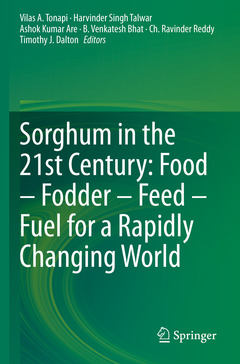Sorghum in the 21st Century: Food – Fodder – Feed – Fuel for a Rapidly Changing World, 1st ed. 2020
Coordonnateurs : Tonapi Vilas A., Talwar Harvinder Singh, Are Ashok Kumar, Bhat B. Venkatesh, Reddy Ch. Ravinder, Dalton Timothy J.

Sorghum is the most important cereal crop grown in the semi-arid tropics (SAT) of Africa, Asia, Australia and Americas for food, feed, fodder and fuel. It is the fifth most important cereal crop globally after rice, wheat, maize and barley, and plays a major role in global food security. Sorghum is consumed in different forms for various end-uses. Its grain is mostly used directly for food purposes. After the release of the proceedings of two international symposia in the form of books ?Sorghum in Seventies? and ?Sorghum in Eighties?, global sorghum research and development have not been documented at one place. Of course, few books on sorghum have been released that focus on specific issues/research areas, but comprehensive review of all aspects of recent development in different areas of sorghum science has not been compiled in the form a single book. This book is intended to fill in a void to bridge the gap by documenting all aspects of recent research and development in sorghum encompassing all the progress made, milestones achieved across globe in genetic diversity assessment, crop improvement and production, strategies for high yield, biotic and abiotic stress resistance, grain and stover quality aspects, storage, nutrition, health and industrial applications, biotechnological applications to increase production, including regional and global policy perspectives and developmental needs. This book will be an institutional effort to compile all the latest information generated in research and development in sorghum across the globe at one place.
Dr. Vilas A. Tonapi is Director of ICAR- Indian Institute of Millets Research, Hyderabad, India. He is with the sorghum and Millets programme since 1990. He has also served as Head, Division of Seed Science and Technology, Indian Agricultural Research Institute, New Delhi. He had his graduation and post-graduation from UAS, Bangalaore (Dharwad campus) and Ph.D from TNAU, Coimbatore. He did his post-Doctoral from University of Queensland, Australia. His special attainments include Planning, development and management of crop improvement programs and strategies for food and nutritional security of self and cross-pollinated crops for dry and irrigated ecosystems, Participatory seed system development, Developmental initiatives in seed Technology, seed quality assurance, new seed policy and development of sustainable food and Community seed systems, Seed industry development, Protection of Plant varieties, IPR management, DUS Testing, and Research on physiological, biochemical and molecular basis of seed vigour/longevity. He has been awarded RV Swaminathan He has been the consultant to FAO on seed system development. He was part of USDA Global ergot collection and characterization mission. He has been awarded the distinguished service award to seed industry by Seedsmen Association. He has to his credit 52 research papers in peer reviewed journals, 30 authored and edited books, and more than 75 papers presented in various seminars and symposia.
Dr Harvinder S. Talwar has more than 39 years of research experience in area of stress physiology of legumes, sorghum and small millets. He started his career as researcher in 1981 at International Crops Research Institute for Semi-arid tropics (ICRISAT), Hyderabad. During his association with ICRISAT, his major accomplishments includes developing of cold tolerant chickpea lines and a screening technique for heat tolerance in groundnut. Dr Talwar joined Indian Council of Agricultural Research (ICAR) during 2000 and workedDate de parution : 01-2022
Ouvrage de 940 p.
15.5x23.5 cm
Disponible chez l'éditeur (délai d'approvisionnement : 15 jours).
Prix indicatif 189,89 €
Ajouter au panierDate de parution : 01-2021
Ouvrage de 940 p.
15.5x23.5 cm


